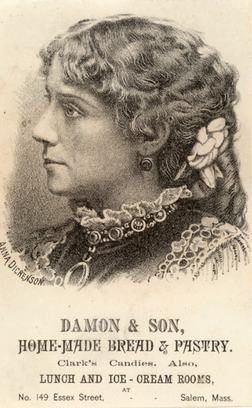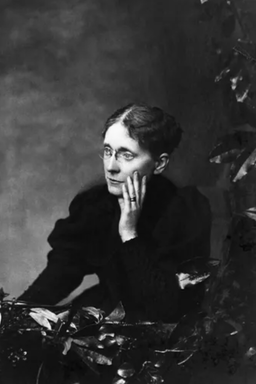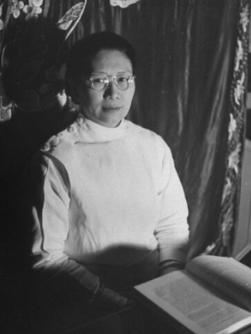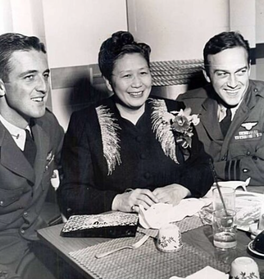Elessar Younglove (they/fae)March 8th is International Women’s Day. Women have overcome various obstacles, and continue the fight for equality today. One example of women’s fight for equality was the women’s suffrage movement. The women’s suffrage movement was an almost century long movement, credited to Susan B. Anthony and Elizabeth Cady Stanton. It was also a safe haven for queer women. Susan B. Anthony began her career as a lecturer for the American Anti-Slavery Society. This doesn’t excuse her racist actions. Anthony and Stanton only advocated for the rights of white women to vote, and sought to exclude Black women from their movement. 1852, after being denied permission to speak at a rally due to being a woman, she turned to women’s rights. She formed an all women temperance organization with Elizabeth Cady Stanton, traveling with her to the New York legislature requesting improvement upon married women’s rights to their husband’s property. Stanton was a wife and mother. Because of this, the two women cared for her children; they split their time between politics and caring for Stanton’s seven children. “So closely interwoven have been our lives, our purposes, and experiences that [when] separated, we have a feeling of incompleteness.” Stanton wrote about her love for Susan Anthony, “I prefer a tyrant of my own sex, so I shall not deny the patent fact of my subjection; for I do believe that I have developed into much more of a woman under her jurisdiction.” Stanton was bound to her husband and seven children, making Anthony the most mobile of the two. Eventually, their relationship made way for other women. Susan B. Anthony was involved in two other documented sapphic relationships. For example, her relationship with public speaker Anna Dickinson. Dickinson was the recipient of many women’s love letters. She was intelligent, confident, beautiful, and a famous admirer of Susan B. Anthony. She wrote Anthony a letter in 1862: “I want to see you very much indeed, to hold your hand in mine, to hear your voice, in a word, I want you - I can't have you? Well, I will at least put down a little fragment of my foolish self and send it to look up at you.” Anthony said that she “never found the man who was necessary to my happiness.” She later settled with Emily Gross, a wealthy wife of a Chicago businessman. Anthony documented her intention to stay with Gross. She informed her niece, Jessie Anthony, and her “niece” Isabel Howland of her affection in the following letter. “I shall go to Chicago & visit my new lover - dear Mrs. [Emily] Gross - 48 Lake Shore Drive en route to Kansas. So with new hope & new life…” It’s significant to note that Susan B. Anthony encouraged many women from the suffrage movement to call her Aunt Susan. In turn, she referred to them as her nieces. “Lover” was not a term used by her admirers and was reserved solely for Emily Gross. In an 1894 letter, Susan boasted of Emily's elegance, clothes, and house where Susan stayed with her. “If you could have seen Mrs. Gross in her ‘Worth’ made dress,” she gushed. Anthony bragged of their relationship to the San Francisco Chronicle on June 28th, 1986. “I'm sure no man could have made me any happier than I have been.... I never found the man who was necessary to my happiness. I was very well as I was.” From then on, these women traveled everywhere together. After Anthony’s death, Gross mourned her loss. A mutual friend revealed, “Times are very hard with dear Mrs. Gross I fear.” Anthony and Stanton’s activism was far from perfect. Notably, they explicitly campaigned for white women’s right to suffrage, excluding women of color from their feminist vision. In fact, Stanton and Anthony did not permit Black women into their famous Seneca Falls convention in 1848. Stanton and Anothony’s accomplishments ought to be recognized for what they were: immensely important landmarks in the history of the women’s suffrage movement that nonetheless advanced the rights of white women while simultaneously shutting out women of color and further promoting racism within feminist spaces. However, while Stanton and Anthony may not be perfect role models, the erasure of queerness throughout history is nevertheless a process that we should actively resist. As we remember early suffragists as the multidimensional, complex, and sometimes-racist figures that they are, that should include their queer identities. Frances Willard is most known for her work in the temperance movement. The temperance movement was a social movement that took place from about 1800 to 1933. It sought to ban alcohol in order to stop men from spending their wages on alcohol and engaging in domestic violence, both of which women were powerless to stop. She was president of the Women’s Christian Temperance Union, a leading group in the temperance movement. She was also queer. She documented her childhood with various instances of gender nonconformity. Willard claimed that she despised wearing feminine clothing growing up. She also wrote that she preferred tasks usually controlled by men, such as constructing sleds and maintaining firearms. “No girl went through a harder experience than I when my free, out-of-door life had to cease,” she wrote, “and the long skirt and clubbed-up hair spiked with hair-pins, had to be endured.” Like most gender nonconformists of the time, Willard was cautious with public displays of her gender. After all, she had an important job to play. Gender nonconforming suffragists like Willard, Chung, and Annie Tinker were encouraged to wear dresses and long hair. Other suffragists feared the transphobic criticism would undermine their work and cost them support. Willard felt most safe disclosing her preferred name in childhood and to her many romantic women partners. She preferred to be called Frank. These women were not described as lesbians, but rather as manlike women. They were often referred to as “unsexed.” It’s unclear if these women were nonbinary or transgender as these terms didn’t yet exist. In modern times, some may have identified as transgender. For example, Margaret Chung wore masculine clothing in medical school and referred to herself as “Mike.” Annie Rensselaer Tinker was a wartime volunteer and a leading suffragist in New York State. Growing up, she and her family spent every summer vacationing in Setauket, Long Island. Setauket freed her of societal expectations. In his memoir, her older brother Edward wrote: “Here my sister and I learned to swim and sail boats. It was a wonderful place for youngsters.” Long Island made Annie free, and it gave her the courage to fight for her happiness and independence. Tinker’s family was wealthy and highly respected. But Annie had no interest in pursuing high society. Instead, she focused on social movements like women’s suffrage. As a young adult, Annie surrounded herself with independent female artists, professionals, and socialites who pursued their dreams. Tinker admired her friends greatly and used her equestrian skills to form and train them and their horses to lead a women’s cavalry in 1911 that protected suffragists participating in parades. Tinker told the Washington Post that Miss Inez Milholland, Miss Marie Zimmerman, and other “well-known young suffragists” were part of her cavalry. Inspired by her friends, Annie decided to join the Women's Political Union, founded by Harriot Stanton Blatch, Elizabeth Cady Stanton’s daughter. Tinker was no stranger to protecting others. As a child, she dived into Port Jefferson Harbor to save a drowning man named Louis Jean Dazib. She also stopped a forest fire in 1913, near Crystal Brook Park Road in Mt. Sinai. Her bravery was documented in the local paper: “Miss Annie Tinker, who has on more than one occasion endeared herself to the people of this community, appeared with her automobile and a man servant armed with a shovel, and with the help of others at last stopped further progress of the fire.” In 1914, Annie returned to boats. But this time, she left for World War I. She sailed to Europe and volunteered with the Red Cross. The United States had yet to join the war effort (and would not do so until three years later), so Annie joined the British Red Cross. She endured much strife overseas. Germany overtook the hospital in Belgium where Annie was volunteering as director. Miraculously, she survived. She was later sent to Naples, Italy, where she met Kate Darling Nelson. The two women formed a private romantic relationship. It was documented on June 27th, 1918 when Tinker wrote out her will. She chose Kate as her sole heir. The will gave Kate “sole benefit and use during her lifetime” of Annie’s property, with the principal thereafter to be donated to charity to benefit “women who worked for a living.” In 1921, Tinker was awarded a Medal of Honor from the French government for her service in the war and her work “in proximity to the enemy for an extended time.” Tinker also organized a procession of 10,000 women down Fifth Avenue to advocate for suffrage. An accomplished equestrian, she planned to lead on horseback, but was later hospitalized for appendicitis on the day of the event, according to the New York Tribune. But not all of New York rooted for her. Tinker often dressed in a traditionally masculine look and was once chided by The New York Times for her “mannish garb.” She never let these comments stop her and continued using her wealth and influence to aid others. Because of her, nearly one hundred women received assistance and recognition from her charity clause when she wrote her will in 1918. Alice Dunbar-Nelson was famous for her journalism, poetry, and political activism. She began as an English and Drama teacher at Wilmington’s Howard High School. She was also an incredible writer, starting conversations on racism and sexuality through fiction and non-fiction. Her first collection, “Violets and Other Tales” (published in 1895) is often referred to as the first-ever short story collection ever published by an African-American woman. Alice knew how important it was to share her thoughts with others. And she understood the expectations of cishet audiences. She cultivated a heterosexual image as “Mrs. Paul Laurence Dunbar,” widow of the famous African American poet Paul Laurence Dunbar (1898 - 1906). Her writing took center stage in 1913, when she became the co-editor of the A.M.E. Review, a popular church publication, and then went on to edit the progressive Black newspaper the Wilmington Advocate in 1920. Around the same time, she became an activist, suffragette, and well-known figure in the Harlem Renaissance. Her writing (columns, articles, fiction, and poetry) became more political, and she emerged as a well-known and outspoken figure in the publishing world. But as a woman, and as a woman of color, she was frequently denied pay for her labor, which she documented. Many publishers turned her down because they thought her work was too difficult to understand. Dunbar-Nelson was an organizer for the Congressional Union (which would become the National Woman’s Party after 1916) and lobbied for a federal women’s suffrage amendment. She sent field organizers out to rally support, forming local branches in cities throughout the nation. She then toured Pennsylvania and New Jersey, using her voice to attract black and white audiences to support women’s right to vote. Even after remarriage in 1916, she kept her abusive late husband’s name for its integrity and connections. She maintained the image of a heterosexual women, but privately, she documented romantic and sexual relationships with men and women in her single and married life. Her diary revealed a thriving lesbian and bisexual subculture among Black suffragists and club women. In 1918, she acted as a field representative for the Women's Committee of the Council of Defense. She also organized for the women's suffrage movement in the mid-Atlantic states. Nelson decried racial discrimination and violence against Black Americans, and was the first Black woman on the Delaware Republican Committee. In 1924, she campaigned for the passage of the Dyer Anti-Lynching Bill. She was highly respected amongst her peers, and later became a professor and administrator of summer classes for the State College for Colored Students, now known as Delaware State University. Alicia Stone Blackwell is a sapphic suffragist who challenged gender norms. She was born in 1857 and died in 1950. Her near century of activism played a key role in combining two prominent women’s suffrage organizations, the National Woman Suffrage Association and the American Woman Suffrage Association. According to Lillian Faderman, author of “To Believe in Women: What Lesbians Have Done For America,” Blackwell refused to call herself an invert. Invert was a shortened version of sexual invert and a euphemism for homosexuality. She expressed romantic interest in her lifelong friend Kitty Barry. Barry was an Irish orphan adopted by Elizabeth Blackwell in 1854 in New York. Barry worked as her mother’s secretary. She was partially deaf, a fact she was self-conscious around everyone but Alicia Stone Blackwell. Blackwell came from a long line of pioneering women. Her aunts Elizabeth and Emily Blackwell were two of the country's first female physicians, and her aunt Antoinette Brown Blackwell was the first woman in the United States to be ordained as a pastor. As a child, Blackwell spent a lot of time with her adopted cousin Katharine “Kitty” because her parents were both sought-after speakers on abolition and women's suffrage. Together, “Kitty” Barry and Blackwell challenged gender norms. They referred to themselves as Captain Robert Kidd and his bride Alice, and signed their letters as “dear betrothed” and “your faithful lover.” At just 16 years old Blackwell began writing for the “Woman's Journal,” a suffrage journal started by her parents, and rose through the ranks to become an editor at the age of 26. Blackwell published the “Woman's Column,” a suffrage weekly distributed to mainstream newspapers, when she was in her early thirties. Blackwell was also instrumental in bringing the American Woman Suffrage Association and the National Woman Suffrage Association together in the woman suffrage campaign. After decades of rivalry between the two organizations, the former led by her parents and the latter by Susan B. Anthony and Elizabeth Cady Stanton, Blackwell helped organize the National American Woman Suffrage Association (NAWSA) in 1890. She was also the recording secretary for NAWSA for nearly 20 years. Angeline Weld Grimké was a journalist, teacher, playwright, and poet who overcame much adversity in her lifetime. The concept of race shaped her. Despite being 75% white, with a white mother and a half-white father, society defined Grimké by her Blackness. Grimké was a Harlem Renaissance poet. The Harlem Renaissance had one of the most important influences onAmerican poetry. It’s defined by lyricism rooted in popular blues and jazz music of the day, awareness of Black life in America, assertion of a distinct African American identity, and creativity in form and structure. Grimké’s first experience with advertising came from her parents' separation when she was just three years old. Initially, she lived with her white mother. At seven years old, she was returned to her father's care and never saw her mother again. Grimké and her father formed an unbreakable bond and worked together to combat racism in America. Grimké’s father was the vice president of the National Association for the Advancement of Colored People, NAACP, and she was frequently published in the association’s magazine “The Crisis.” She used her talents and position to discuss racism and sexuality. In some of her most famous poems, she expressed sexual desire for other women. “Snare of the shine of your teeth/Your provocative laughter/The gloom of your hair/Lure of you, eye and lip/Yearning, yearning,” she wrote in “El Beso,” written in 1909 and later published in “Selected Works of Angelina Weld Grimké.” In college, Grimké attended the Boston Normal School of Gymnastics (now part of Wellesley College) and attended supplemental classes at Harvard University. Grimké was a proud abolitionist and suffragist. She believed the right to vote was essential to women’s independence and equality. She made friends with prominent suffragists and activists Mary Church Terrell and Coralie Franklin Cook, both of whom were active in the National American Woman Suffrage Association and the Black women's club movement. She was also a member of an influential group of Washington, D.C.-based Black women suffragists that included Terrell, Cook, Nannie Helen Burroughs, Anna Julia Cooper, and others. Dr. Margaret Chung was the first American-born Chinese woman to become a physician in the United States. She endured much strife in her lifetime; she was rejected by the Presbyterian missionary board because of her race, and the government because of her sexuality. Yet she opened her arms to others, especially soldiers. She overcame sexism, racism, and homophobia to found one of the first Western medical clinics in San Francisco’s Chinatown in the 1920s. I’m the 1930s, Chinatown was a haven for bohemian artists, poets, and queer folk like Elsa Gidlow. But in the 1920s many Chinatown residents distrusted Dr. Chung. According to Chung’s biographer Judy Tzu-Chun Wu, the doctor preferred to dress in men’s clothing. Her slicked-back hair, black tailored suit, hat, and cane were her trademark. She also continued using the name Mike with her friends, suggesting that she was gender non conforming in her education and personal life. It is unclear if she used the moniker in her work. In the 20th century it was dangerous to deviate from gender norms, something Dr. Chung was likely aware of. Her “unladylike” behavior shone through with drinking, gambling, and swearing. Citizens of Chinatown detested her wardrobe and spread rumors of her sexuality, labeling her “an outsider and a lesbian.” While Dr. Chung never confirmed these rumors, she had romantic relationships with multiple women, including the openly lesbian poet Elsa Gidlow and the vaudeville entertainer Sophie Tucker. She also frequented gay nightclubs like Mona’s and the Black Cat. Dr. Chung was the oldest of eleven children in a Christian family. She was no stranger to rejection. But she never let it define her. Despite the homophobia and sexism in Chinatown, she became a successful physician and was highly respected by her patients. The “exotic” appeal of Chinese medical treatments to white patients was harmful and stereotypical, but Chung welcomed these patients and continued to attract non-Chinese patients. But her work didn’t stop there. In the late 1930s, Chung used her talents to treat and feed Navy pilots. When Japan invaded in 1937 she was assigned a secret mission to recruit pilots for the First American Volunteer Group.
In World War II, Dr. Chung was a founding member of the U.S. naval organization Women Accepted for Volunteer Emergency Service. The government rejected her application due to her race and suspicion of her being a lesbian. In response, she became a war doctor. Her recruitment activities from 1937 led her to build a network of thousands of men in the army. By the end of World War II, these men had become family to her and lovingly referred to her as “Mom Chung” for her kind letters, gifts, and loving home open to her sons. International Women’s Day is a global celebration of women’s accomplishments and courage. Each woman led a unique life, and dared to defy the social norms of her time. Some women fought in the war, while others found swords in their pens. They were strong, proud, and deserving of the peace they fought for. And yet many are forgotten. The erasure of queerness throughout history is a process that we should actively resist. These women fought for the world, and now, we fight for them. Memorializing their work and their lives is only the beginning.
0 Comments
Leave a Reply. |
Search by typing & pressing enter









